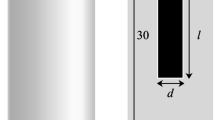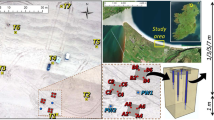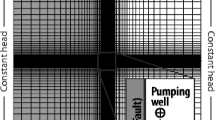Abstract
All aquifers have some degrees of heterogeneity, which if extreme, can adversely affect the performance of ASR systems. There are many types of aquifer heterogeneity that may be encountered in the field. Two of them are considered here: non-uniform distribution of transmissivity in the storage zone and dual porosity. As indicated by the flowmeter log data, the hydraulic conductivity values may vary by several orders of magnitude within the target storage zone. The heterogeneity introduced by the variable distribution of flow zones may affect the performance of an ASR system. Dual-porosity conditions are often encountered in storage aquifers, which can significantly impact the recovery efficiency of an ASR system. Several cases of heterogeneity and their potential impacts on ASR system recovery efficiency were investigated by simulations of hypothetical ASR systems with reasonable input parameters. Modeling results indicate that aquifer heterogeneity will reduce the performance of ASR systems, compared to systems using a homogeneous aquifer. Existence of dual-porosity conditions has a tendency to lower the recovery efficiency of an ASR system when freshwater is injected into the native brackish water due to mixing and differential solute travel time. Buoyancy effects are more pronounced in the fractured domain than in a homogenous system. This resulted in a wider freshwater plume in the shallower layers within the fractured domain. The simulation results also suggest that recovery efficiency can be improved by setting the extraction point shallower than the injection point.





Similar content being viewed by others
References
Budd DA, Vacher HL (2004) Matrix permeability of the confined Floridan aquifer. Hydrogeol J 12:531–549
Guo W, Bennett GD (1998) Simulation of saline/freshwater flows using MODFLOW. In: Proceedings of MODFLOW ‘98, Colorado School of Mines, Golden vol 1, pp 267–274
Guo W, Langevin CD (2002) User’s guide to SEAWAT: a computer program for simulation of three-dimensional variable-density ground-water flow. open-file report 01-434. US geological survey, Tallahassee
Kazemi H, Merrill LS, Porterfield KL, Zeman PR (1976) Numerical simulation of water-oil flow in naturally fractured reservoirs, 5719-PA, SPE J Pap, vol 16, pp 317–326
Maliva RG, Missimer TM (2010) Aquifer storage and recovery and managed aquifer recharge: planning, hydrogeology, design and operation: methods in water resources evaluation series No. 2. Schlumberger Corporation, Houston
Missimer TM, Guo W, Walker CW, Maliva RG (2002) Hydraulic and density considerations in the design of aquifer storage and recovery systems. Fla Water Resour J 2002:30–36
Pavelic P, Dillin PJ, Simmons CT (2006) Multiscale characterization of a heterogeneous aquifer using an ASR operation. Ground Water 44(2):155–164
Poeter E, Gaylord DG (1990) Influence of aquifer heterogeneity on contaminant transport at the Hanford site. Ground Water 28(6):900–909
Quiñones-Aponte V, Wexler EJ (1994) Preliminary assessment of injection, storage, and recovery of freshwater in the lower hawthorn aquifer, Cape Coral, Florida, US geological survey water-resources investigations report 94-412
Reese R, Alvarez-Zarikian CA (2006) Hydrogeology and aquifer storage and recovery performance in the Upper Floridan Aquifer, Southern Florida, USGS scientific investigations report 2006-5239
Schlumberger (2011) Eclipse reservoir simulation software, technical description version 2011.2. Schlumberger Corporation, Houston
Tihansky AB (2004) Effects of aquifer heterogeneity on ground-water flow and chloride concentrations in the Upper Floridan Aquifer near and within an active pumping well field, West-Central Florida, USGS scientific investigations report 2004-5268
Vacher HL, Hutchings WC, Budd DA (2006) Metaphors and models: the ASR bubble in the Floridan aquifer. Ground Water 44(2):144–154
Ward JD, Simmons CT, Dillon PJ (2008) Variable-density modeling of multiple-cycle aquifer storage and recovery (ASR): importance of anisotropy and layered heterogeneity in brackish aquifers. J Hydrol 356:93–105
Acknowledgments
The authors greatly appreciate the careful review and comments from anonymous reviewers for their helpful comments. We would like also thank Lisa Latkowski of Schlumberger Water Services for her editorial review of this manuscript.
Author information
Authors and Affiliations
Corresponding author
Rights and permissions
About this article
Cite this article
Guo, W., Coulibaly, K. & Maliva, R.G. Simulated effects of aquifer heterogeneity on ASR system performance. Environ Earth Sci 73, 7803–7809 (2015). https://doi.org/10.1007/s12665-014-3822-4
Received:
Accepted:
Published:
Issue Date:
DOI: https://doi.org/10.1007/s12665-014-3822-4




